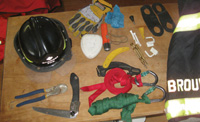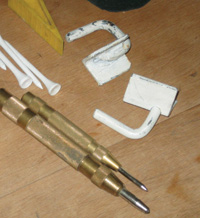
Equipment
Trainer’s Corner: March 2010
The last few topics in Trainer’s Corner have been somewhat intense, so I thought it might be time for something a little lighter. Much like the question asked by the spokesperson for ING Banking, What’s in your wallet? I ask you, What’s in your turnout gear?
March 15, 2010
By Ed Brouwer
The last few topics in Trainer’s Corner have been somewhat intense, so I thought it might be time for something a little lighter. Much like the question asked by the spokesperson for ING Banking, What’s in your wallet? I ask you, What’s in your turnout gear?
During our SOO HOT weekends our instructors often get firefighters to don their PPE and then ask them to empty their pockets. The results: everything you can imagine to nothing whatsoever.
 |
||
| Ed brouwer carries a flashlight, webbing, golf tees, centre punches, gloves, cutters, multi-tool, valve stem remover, face mask, notebook and pen, chocks, latch stoppers, rope, folding saw and wire cutters.
Photos by Ed brouwer
|
||
 |
It may seem a bit harsh but we ask the firefighters carrying nothing if they actually know the purpose of those big pockets on their bunker gear. One group of firefighters said their department didn’t allow them to carry tools in their pockets. The department feared making holes into the gear.
I know I could get into trouble, but I tell firefighters it’s their gear. It is fitted to you. It is your protection. A tool in your pocket could very well save your life, or the lives of your fellow firefighters. Imagine being hooked by a piece of wire that could easily be cut by a pair of wire cutters, but alas the cutters are in the toolbox on the truck. Now it becomes a RIT situation and more firefighters are put at risk. There is no honour in a LOD death that could have been prevented by carrying a $14 pair of cutters, whether or not they may cause a wear hole in the gear.
There are different schools of thought regarding which equipment should be carried in your bunker gear. As you read the list below, please keep in mind that some firefighters respond only to structure fires, while others respond to all types of calls – MVIs, structural fires, vehicle fires, urban interface fires, first response medical and others.
We asked a number of firefighters these questions:
- What’s in your turnout gear?
- Why did you choose that specific item?
I have listed their responses by item name followed by the various amounts or types:
- Webbing: 24 feet of one-inch tubular webbing; 16 feet of webbing.
- Carabineers: two steel; three aluminum.
- Gloves: structural; rescue; rope; latex; medical.
- Knife: first responder knife; utility knife; Swiss Army knife.
- Rope: 75 feet of personal escape rope; 30 feet (7mm) utility rope; 40 feet of utility rope.
- Door chocks: multiple chocks; wooden; plastic; metal.
- Flashlight: Survivor flashlight; right angle; smoke eater; extra flashlight; helmet light; Pelican handheld.
- Screwdrivers: Five in one; one of each.
- Leatherman tool: various types and sizes.
- Pliers: Lineman; cable cutter; wire cutter; side cutter; battery cable cutter; channel lock; vice-grips.
- Wrenches: Torx bit; Hex (Allen Key) wrenches; Res-Q-Wrench.
- Odds and ends: Golf tees; one-inch radiator hose clamps; window punch; seatbelt cutter; a picture of family / people cared for; safety glasses; and pocket mask.
As you can see, it’s quite a list. After deciding what you need to carry, the next question is where? Realtors say, “Location, location, location.” In this case, location is everything. Think about trying to get at your wire cutters while wearing SCBA and lying on your side. Some firefighters keep structure tools such as wedges or webbing on the right side, and auto extrication tools such as seatbelt cutters, a Res-Q-Wrench or a window punch on the left. Bunker pant pockets usually carry hand protection, rope, utility gloves and more webbing.
■ What you may not need to carry
One firefighter carried an extra Nomex hood for filter breathing during SCBA failure. This is not a good idea. Firefighters with SCBA malfunction or failure have a better chance of being revived if they keep their mask on. Inhaling even a trace amount of super heated fire gases may cause the larynx to close, thereby robbing you of breath. Air management and calling a mayday early give you the best chance of survival.
One firefighter suggested carrying an electrical tester. Although this may help during the investigation stage, in the heat of battle with the fire dragon, treating wires as live is your best bet for survival.
It seems a large number of firefighters carry Leatherman tools or multi-tools but I wonder how many have actually used them in a fire? These small tools are awkward to open and work with at the best of times let alone with gloves on in poor light.
■ Some suggestions
The No. 1 thing you should have in your pockets is an extra flashlight. I tied a short piece of leather strip to the flashlight; it hangs out of my pocket for a quick find.
There are a variety of door wedges being carried. Being able to ensure that the door you just opened stays open could mean the difference between life and death. Door wedges can also be used to stop sprinkler heads. The plastic wedges slip out of position easily; the wooden ones are a bit better but the best are our homemade steel ones – simply a piece of one-inch, angle-iron cut into one-inch pieces with a one-inch steel rod hook welded to it. Hang the hook over the hinge of the opened door and the angle iron keeps it from closing.
I don’t carry vice grips but some firefighters swear by them to loosen or tighten bolts, as a door wedge or they clamp the vice grips on an overhead track to keep the door from coming down. I carry two lengths of webbing; 12 feet (looped to six feet) of one-inch webbing tied with a water knot attached to a four-inch aluminum carabineer, and a 20-foot (looped) piece also tied with a water knot and attached to a four-inch aluminum carabineer. They can be used separately or hooked together for longer reach. Their main purpose is for self-rescue and RIT operations. Other uses include carrying tools and lowering and raising tools.
Because we respond to many MVIs, I carry some special items: four golf tees to use as quick plugs for fuel tank leaks; two spring-loaded centre punches for popping windows; heavy duty latex gloves to be worn under my extrication gloves in case of the need to help with EHS; heavy duty cutters for battery cables; and a Task Force multitool that includes a seatbelt cutter.
I made a valve stem remover so that rather than cutting the valve stem off to deflate the tires I can just take out the valve stem. Then, when the tow truck operator needs to load the vehicle, we replace the valve stem and use the compressed air from the tow truck to re-inflate the tires. I carry a pocket mask in its case in my inner coat pocket. I also carry a small notebook and pen. At my age, I dare not rely on memory alone!
For structure fires, I carry two steel door chocks, one plastic door chock, two door latch stoppers made from a piece of inner tube with two, one-inch holes cut in them (looks like a Zorro mask). Stretch one hole over the doorknob, pull the inner tube over the latch and hook the second hole over the doorknob on the other side of the door. Should the door close it can’t latch because of the inner tube. I also carry 50 feet of three-eighths inch braided rope. I can use it for large area searches or as a RIT recall line.
Among my favourite tools are a folding saw and HD wire cutters. The wire cutters are 9.5 inches long with insulated handles. They have an incredibly powerful two-inch bite. My wife bought me the Pocket Boy Folding Saw for Christmas one year. It is lightweight with a seven-inch micro blade that cuts through a 2×4 stud in seconds. I have used my Big Ed clip-on flashlight for six years and it has never failed me.
That sums up the possibilities for your carry-on equipment with one exception – the helmet. I don’t carry tools in my helmet but I do carry two things there – my accountability name tags and a photo of my grandkids.
Ed Brouwer is the chief instructor for Canwest Fire in Osoyoos, B.C., and the training officer for West Boundary Highway Rescue. The 20-year veteran of the fire service is also a fire warden with the B.C. Ministry of Forests, a wildland interface fire suppression instructor/evaluator and a fire-service chaplain. Contact Ed at ed@thefire.ca
Print this page